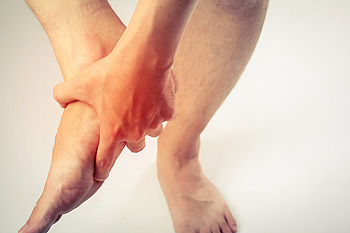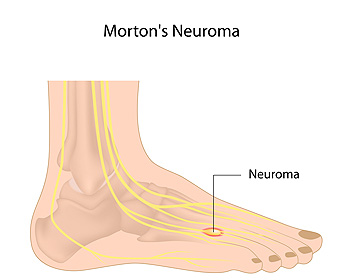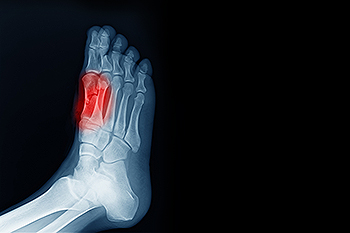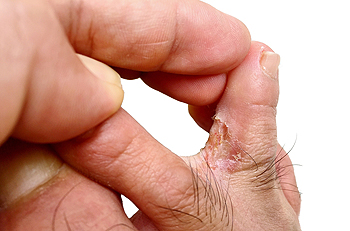Connect With Us
Blog
Items filtered by date: August 2023
Understanding Plantar Fasciitis

Plantar fasciitis, the inflammation of the tissue on the bottom of your foot, causes heel pain and discomfort and often worsens with physical activity. Risk factors include activities stressing your heel, being overweight, pregnant, or having high arches. Beyond heel pain, symptoms of plantar fasciitis include aching, burning, or swelling. This discomfort is typically most pronounced in the morning or after prolonged sitting, standing, or activity. Causes vary from playing sports to being on your feet a lot, poor arch support, or tight calf muscles. Treatment involves rest, wearing supportive footwear, using orthotics, and stretching the affected area. In severe cases, steroid injections or surgery might be considered. Prevention includes maintaining a healthy weight, wearing supportive shoes, warming up before exercise, and allowing recovery between physical activities. If you have heel pain and suspect you might have plantar fasciitis, it is suggested that you make an appointment with a podiatrist for a proper diagnosis and treatment.
Plantar fasciitis can be very painful and inconvenient. If you are experiencing heel pain or symptoms of plantar fasciitis, contact Scott Matthews, DPM, MD from Salem Foot Care . Our doctor can provide the care you need to keep you pain-free and on your feet.
What Is Plantar Fasciitis?
Plantar fasciitis is the inflammation of the thick band of tissue that runs along the bottom of your foot, known as the plantar fascia, and causes mild to severe heel pain.
What Causes Plantar Fasciitis?
- Excessive running
- Non-supportive shoes
- Overpronation
- Repeated stretching and tearing of the plantar fascia
How Can It Be Treated?
- Conservative measures – anti-inflammatories, ice packs, stretching exercises, physical therapy, orthotic devices
- Shockwave therapy – sound waves are sent to the affected area to facilitate healing and are usually used for chronic cases of plantar fasciitis
- Surgery – usually only used as a last resort when all else fails. The plantar fascia can be surgically detached from the heel
While very treatable, plantar fasciitis is definitely not something that should be ignored. Especially in severe cases, speaking to your doctor right away is highly recommended to avoid complications and severe heel pain. Your podiatrist can work with you to provide the appropriate treatment options tailored to your condition.
If you have any questions please feel free to contact our office located in Wikesboro, NC . We offer the newest diagnostic and treatment technologies for all your foot and ankle needs.
Causes of Morton’s Neuroma

Foot pain can significantly impact one's quality of life, limiting activities like walking, exercising, and even playing with your children. Morton's neuroma is an increasingly common condition that arises from the thickening of nerve tissues in the foot due to extreme compression and irritation. The condition stems from compression of the plantar digital nerves and can lead to permanent damage if not treated promptly. Morton's neuroma most often occurs between the third and fourth toes. Women are more susceptible, possibly due to wearing high-heeled shoes. Improper foot biomechanics, like flat feet or high arches, can also contribute by creating instability around the toe joints. Symptoms of Morton's neuroma include pain, tingling, numbness, and burning sensations, often felt between the toes or in the ball of the foot. Swelling is common, particularly between the toes. Tight, narrow-toed shoes can increase nerve stress and make matters worse. Walking, especially on stairs, can further intensify the pain. Non-surgical interventions include custom orthotic shoe inserts, wearing comfortable shoes with room for the toes, and taking anti-inflammatory medication. Early consultation with a podiatrist is suggested for tailored treatment plans and to avoid surgery.
Morton’s neuroma is a very uncomfortable condition to live with. If you think you have Morton’s neuroma, contact Scott Matthews, DPM, MD of Salem Foot Care . Our doctor will attend to all of your foot care needs and answer any of your related questions.
Morton’s Neuroma
Morton's neuroma is a painful foot condition that commonly affects the areas between the second and third or third and fourth toe, although other areas of the foot are also susceptible. Morton’s neuroma is caused by an inflamed nerve in the foot that is being squeezed and aggravated by surrounding bones.
What Increases the Chances of Having Morton’s Neuroma?
- Ill-fitting high heels or shoes that add pressure to the toe or foot
- Jogging, running or any sport that involves constant impact to the foot
- Flat feet, bunions, and any other foot deformities
Morton’s neuroma is a very treatable condition. Orthotics and shoe inserts can often be used to alleviate the pain on the forefront of the feet. In more severe cases, corticosteroids can also be prescribed. In order to figure out the best treatment for your neuroma, it’s recommended to seek the care of a podiatrist who can diagnose your condition and provide different treatment options.
If you have any questions, please feel free to contact our office located in Wikesboro, NC . We offer the newest diagnostic and treatment technologies for all your foot care needs.
How to Find Relief From Sesamoiditis

Sesamoiditis is a painful condition that affects the sesamoid bones, which are two small bones in the foot located beneath the big toe joint. These bones play a crucial role in providing leverage for the tendons and muscles, allowing smooth movements during activities such as walking and running. Sesamoiditis occurs when these bones become inflamed, which generally happens from overuse, repetitive impact, or excessive pressure. The primary symptom of sesamoiditis is sharp pain beneath the big toe, which worsens during weight-bearing activities. Treatment for sesamoiditis involves rest and taking anti-inflammatory medications to reduce pain and inflammation. Wearing supportive footwear, padding, and orthotic inserts can alleviate pressure on the affected area. In severe cases, a podiatrist may recommend immobilization with a walking boot or cast to allow the sesamoid bones to heal properly. Proper management and early intervention are essential to prevent long-term complications and ensure a swift recovery from sesamoiditis. If you are afflicted with sesamoiditis, it is strongly suggested that you contact a podiatrist who can help you to manage this condition.
Sesamoiditis is an unpleasant foot condition characterized by pain in the balls of the feet. If you think you’re struggling with sesamoiditis, contact Scott Matthews, DPM, MD of Salem Foot Care . Our doctor will treat your condition thoroughly and effectively.
Sesamoiditis
Sesamoiditis is a condition of the foot that affects the ball of the foot. It is more common in younger people than it is in older people. It can also occur with people who have begun a new exercise program, since their bodies are adjusting to the new physical regimen. Pain may also be caused by the inflammation of tendons surrounding the bones. It is important to seek treatment in its early stages because if you ignore the pain, this condition can lead to more serious problems such as severe irritation and bone fractures.
Causes of Sesamoiditis
- Sudden increase in activity
- Increase in physically strenuous movement without a proper warm up or build up
- Foot structure: those who have smaller, bonier feet or those with a high arch may be more susceptible
Treatment for sesamoiditis is non-invasive and simple. Doctors may recommend a strict rest period where the patient forgoes most physical activity. This will help give the patient time to heal their feet through limited activity. For serious cases, it is best to speak with your doctor to determine a treatment option that will help your specific needs.
If you have any questions please feel free to contact our office located in Wikesboro, NC . We offer the newest diagnostic and treatment technologies for all your foot and ankle needs.
How Athlete’s Foot Spreads

Athlete’s foot is a pesky kind of foot condition in which the skin between the toes becomes irritated and flaky due to a fungal infection. Interestingly, athlete's foot is contagious because the fungal infection can spread from one person to another. There is a very particular way in which an athlete’s foot infection spreads between people. Namely, when an individual with athlete’s foot walks barefoot on a surface, they leave behind fungal spores. These spores can attach to many things such as shoes, clothes, furniture, and more. When another person comes into contact with these spores, they can also contract the fungal infection. If you have athlete's foot or are looking to protect yourself from developing it, it is suggested that you contact a podiatrist today for treatment.
Athlete’s foot is an inconvenient condition that can be easily reduced with the proper treatment. If you have any concerns about your feet and ankles, contact Scott Matthews, DPM, MD from Salem Foot Care . Our doctor will treat your foot and ankle needs.
Athlete’s Foot: The Sole Story
Athlete's foot, also known as tinea pedis, can be an extremely contagious foot infection. It is commonly contracted in public changing areas and bathrooms, dormitory style living quarters, around locker rooms and public swimming pools, or anywhere your feet often come into contact with other people.
Solutions to Combat Athlete’s Foot
- Hydrate your feet by using lotion
- Exfoliate
- Buff off nails
- Use of anti-fungal products
- Examine your feet and visit your doctor if any suspicious blisters or cuts develop
Athlete’s foot can cause many irritating symptoms such as dry and flaking skin, itching, and redness. Some more severe symptoms can include bleeding and cracked skin, intense itching and burning, and even pain when walking. In the worst cases, Athlete’s foot can cause blistering as well. Speak to your podiatrist for a better understanding of the different causes of Athlete’s foot, as well as help in determining which treatment options are best for you.
If you have any questions please feel free to contact our office located in Wikesboro, NC . We offer the newest diagnostic and treatment technologies for all your foot and ankle needs.
Causes and Treatment of Bunions

A bunion is an unsightly and often painful deformity of the big toe, termed hallux valgus. This deformity starts in the bottom joint of the big toe, causing the bone to jut out sideways and push the top part of the toe toward the second toe. This can result not only in foot alignment issues but also problems with gait and weight bearing. A bunion is often very painful as the misshapen big toe rubs against the inside of the shoe and places more pressure on the ball of the foot. The major cause of bunions is believed to be genetic, but ill-fitting footwear and high-heeled shoes are other possible causes. In some cases, a bunion may be caused by rheumatoid arthritis. The first and simplest way of dealing with a bunion is changing footwear to accommodate the width of the foot and provide more cushioning. Bunion pads and toe spacers also may relieve some of the pain and pressure. In the worst cases, some form of surgery is an option to correct the deformity. The type of operation will be based on the severity of the bunion, along with other factors. For more information on treating a bunion, it is suggested that you make an appointment with a podiatrist.
If you are suffering from bunion pain, contact Scott Matthews, DPM, MD of Salem Foot Care . Our doctor can provide the care you need to keep you pain-free and on your feet.
What Is a Bunion?
Bunions are painful bony bumps that usually develop on the inside of the foot at the joint of the big toe. As the deformity increases over time, it may become painful to walk and wear shoes. Women are more likely to exacerbate existing bunions since they often wear tight, narrow shoes that shift their toes together. Bunion pain can be relieved by wearing wider shoes with enough room for the toes.
Causes
- Genetics – some people inherit feet that are more prone to bunion development
- Inflammatory Conditions - rheumatoid arthritis and polio may cause bunion development
Symptoms
- Redness and inflammation
- Pain and tenderness
- Callus or corns on the bump
- Restricted motion in the big toe
In order to diagnose your bunion, your podiatrist may ask about your medical history, symptoms, and general health. Your doctor might also order an x-ray to take a closer look at your feet. Nonsurgical treatment options include orthotics, padding, icing, changes in footwear, and medication. If nonsurgical treatments don’t alleviate your bunion pain, surgery may be necessary.
If you have any questions, please feel free to contact our office located in Wikesboro, NC . We offer the newest diagnostic and treatment technologies for all your foot care needs.
Blog Archives
- March 2025
- February 2025
- January 2025
- December 2024
- November 2024
- October 2024
- September 2024
- August 2024
- July 2024
- June 2024
- May 2024
- April 2024
- March 2024
- February 2024
- January 2024
- December 2023
- November 2023
- October 2023
- September 2023
- August 2023
- July 2023
- June 2023
- May 2023
- April 2023
- March 2023
- February 2023
- January 2023
- December 2022
- November 2022
- October 2022
- September 2022
- August 2022
- July 2022
- June 2022
- May 2022
- April 2022
- March 2022
- February 2022
- January 2022
- December 2021
- November 2021
- October 2021
- September 2021
- August 2021
- July 2021
- June 2021
- May 2021
- April 2021
- March 2021
- February 2021
- January 2021
- December 2020
- November 2020
- October 2020
- September 2020
- August 2020
- July 2020
- June 2020
- May 2020
- April 2020
- March 2020
- February 2020
- January 2020
- December 2019
- November 2019
- October 2019
- September 2019
- August 2019
- July 2019
- June 2019
- May 2019
- April 2019
- March 2019
- February 2019
- January 2019
- December 2018
- November 2018
- October 2018
- September 2018
- August 2018
- July 2018
- June 2018
- May 2018

